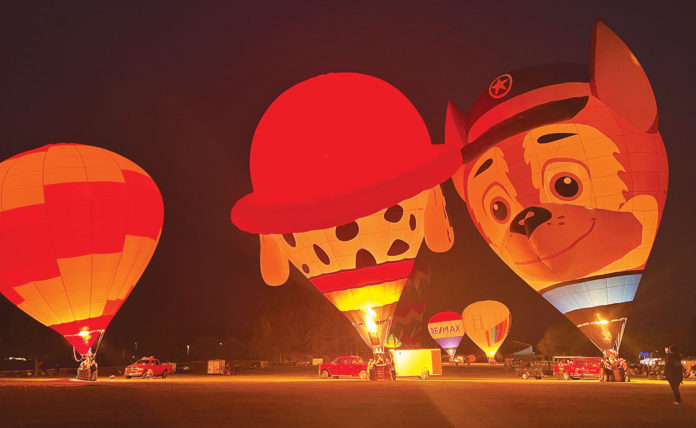
Hot air. Sonoma summer. So much going on, including Sonoma County’s Hot Air Balloon Classic. Early morning reveille and revelry at the County Fairgrounds with gates opening at 4am. Although it was dark, once the hot air balloons “stood up,” propane flames and glowing balloons became a sound-and-light spectacle.
Winds prevented flight on Saturday and Sunday, but a terrific “glow show” occurred Sunday morning. The glow show happens when balloon pilots fire up propane burners, coordinating illuminations, each balloon lighting up in turn. There was also a “twinkle” display, when balloon pilots flared burners and “standing balloons” twinkled randomly.
Fun Facts: Flames from hot air balloon burners rise 6-8 feet. Burners put out 12 million BTU’s/hour; an average household gas burner puts out 10,000 BTU’s, or 0.08%. Hot air balloons travel 4-6 mph; we walk at 3 mph, and 4-6 mph is considered jogging. Winds over 8 mph are borderline unsafe for balloons. Balloon altitudes are generally in the 1,000–3,000 foot range.
The first hot air balloon rose in 1783, heated from a fire on the ground. In 1793, President George Washington witnessed the first hot air balloon flying in America. Hot air ballooning lost favor for over 100 years to balloon flying with lighter gasses.
In the 1950s, when propane tanks and burners could be carried aloft and safely prolong flight, interest in hot air balloons returned. In 1987, Richard Branson crossed the Atlantic. In 1991 he crossed the Pacific, 6,700 miles in 47 hours, achieving speeds close to 250 mph in a hot air balloon.
The movie Around the World in 80 Days, with David Niven and Shirley MacLaine, featured a hot air balloon. Released in 1956, it won five Academy Awards, including Best Picture, grossing $42 million at the box office against $6 million production costs. S. J. Perelman wrote the screenplay.
The novel Around the World in 80 Days, written by Jules Verne, was wildly successful when published serially in Le Temps in 1872, and then in book form in 1873. Phileas Fogg and Passepartout did not travel by balloon in any part of their journey in Verne’s writings.
Consider a hot air balloon ride this summer, and mark your calendar for the festival next year.







